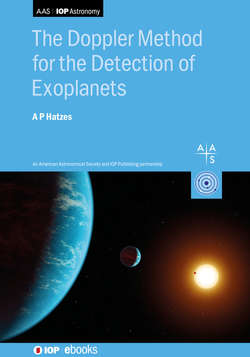Читать книгу The Doppler Method for the Detection of Exoplanets - Professor Artie Hatzes - Страница 24
На сайте Литреса книга снята с продажи.
2.2 Fourier Transform Spectrometers
ОглавлениеMost stellar RV measurements are made with spectrometers using an echelle grating as a dispersing element. Another form of spectrometer is a Fourier transform spectrometer (FTS). Unlike a dispersing spectrometer which measures the intensity over a narrow range of wavelengths at a time, an FTS simultaneously collects high spectral resolution data over a wide spectral range. The FTS is not directly used for RV measurements, but it plays an important role in providing a reference spectrum for the gas absorption cell method (Chapter 6).
An FTS is a Michelson interferometer with a movable mirror (Figure 2.9). Light from a source is split into two beams using a beam splitter. One beam is reflected off a fixed mirror while the other is reflected off a movable mirror, which can vary the optical path length. The combined beams interfere and are recorded at the detector. By measuring the temporal coherence of the light at a different optical path difference, one can convert the time domain signal into a spatial coordinate.
Figure 2.9. The Fourier transform spectrometer. The light source goes through a beam splitter, which divides the light equally into two light paths, L1 and L2. The optical path length L1 remains fixed, but a translating movable mirror changes the optical path length L2. The combined interference beam is recorded at the detector. Moving the translating mirror over a fixed range produces an interferogram in frequency space. A Fourier transform converts this into a spectra in the spatial domain.
If d is the optical path difference of the combined beams at the detector, then for a monochromatic beam of frequency ν0(=λ−1), the intensity is
I(d)=I021+cos(2πν0d).(2.17)
For a polychromatic source, S(ν), only at d = 0 will all the light waves add constructively to produce a signal. The output signal is thus
I(d)=1/2∫0∞S(ν)1+cos(2πν)ddν.(2.18)
If I¯(ν)=2I(d)−I(0), then
I¯(ν)=∫0∞S(ν)cos(2πνd)dν.(2.19)
The function I¯ is called the interferogram, and it is merely the Fourier transform of the source, which can be recovered by the Fourier integral theorem:
S(ν)=∫0∞I¯(d)cos(2πνd)dν.(2.20)
Hence, as the name FTS implies, it is a device that records the Fourier transform of your spectrum.
The resolution of an FTS is determined by the maximum distance that the translating mirror moves during the observation. Thus, it is relatively easy for an FTS to achieve a very high resolving power, typically up to R=500,000−1,000,000. If you want lower resolution, simply move the translating mirror a shorter distance.
There are no reported instances of an FTS being used for precise RV measurements. These instruments, however, play an important role in the absorption cell method (see Chapter 4). The top panel of Figure 2.10 shows a portion of the spectrum of molecular iodine, I2, recorded using an echelle spectrograph with reasonably high resolution, R = 67,000. The lower panel shows the same wavelength region recorded with the McMath FTS (see Deming & Plymate 1994). The resolving power is R ≈ 1,000,000, and one can see that the broad and shallow spectral features seen at lower resolving power is really a myriad of very narrow and deep lines.
Figure 2.10. (Top) A portion of a spectrum of molecular iodine taken using an echelle grating spectrometer with resolving power R = 67,000. (Bottom) The same wavelength segment of molecular iodine taken with an FTS with resolving power R≈1,000,000.
